Category:Retrocomputing
Retrocomputing
I really enjoy working on ancient machines and have restored several antiques to mostly operational condition. Many of my other projects involve adapting modern computers to fit inside or work with older hardware.
More photos of antique computers, some of which I'm working on restoring.
CM-2 "Random and Pleasing"
 MoMA asked about creating replica LED panels for the CM-2 running "Random and Pleasing", so I worked Tamiko Thiel, the original industrial designer of the system, to build them. Read on for a simulation of the front panel and various reference photos.
MoMA asked about creating replica LED panels for the CM-2 running "Random and Pleasing", so I worked Tamiko Thiel, the original industrial designer of the system, to build them. Read on for a simulation of the front panel and various reference photos.
PDP-11/34
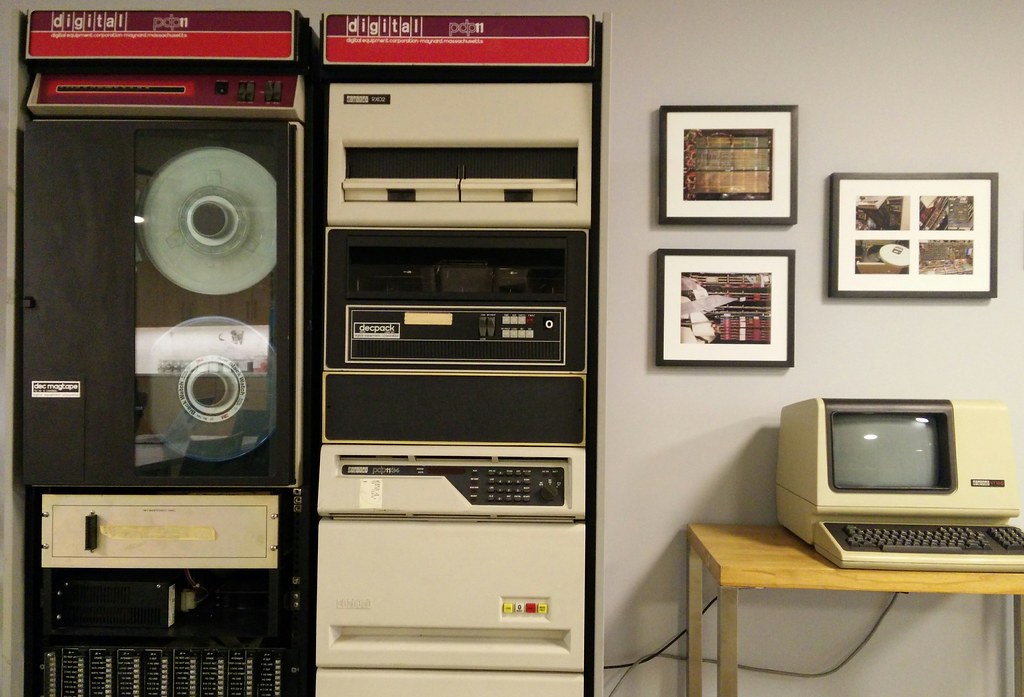 We rescued two PDP-11/34 computers and their associated equipment from a storage unit in the Bronx and have been working on getting one of them running again. It is now on static display at my office. Read on for more details...
We rescued two PDP-11/34 computers and their associated equipment from a storage unit in the Bronx and have been working on getting one of them running again. It is now on static display at my office. Read on for more details...
ADVENT.FOR
 This is a transcript of how to setup simh on a simulated PDP-11, generate a working FORTRAN IV compiler, transfer the original ADVENT source code into the simulator or real PDP-11 hardware, build it and play Colossal Cave Adventure. Read on for the details...
This is a transcript of how to setup simh on a simulated PDP-11, generate a working FORTRAN IV compiler, transfer the original ADVENT source code into the simulator or real PDP-11 hardware, build it and play Colossal Cave Adventure. Read on for the details...
Kaypro 2
 There was a Kaypro 2 in the storage loft at NYCR that booted on the first try. The floppy disk in the drive was "Mickey's Jigsaw Puzzles", but it booted up with CP/M. On the disk was
There was a Kaypro 2 in the storage loft at NYCR that booted on the first try. The floppy disk in the drive was "Mickey's Jigsaw Puzzles", but it booted up with CP/M. On the disk was KERM411.COM, which allowed us to connect it to a remote Unix machine. Read on for the details...
Altair 8800b
 We ended up with a stack of Altair 8800b systems from MITS and "Cyclone" clones of the Altair, as well as a stack of ROM chips. I haven't had time to go through and survey them yet. Read on...
We ended up with a stack of Altair 8800b systems from MITS and "Cyclone" clones of the Altair, as well as a stack of ROM chips. I haven't had time to go through and survey them yet. Read on...
NeXT Computers
 The NeXT computers were one of Steve Job's greatest systems. They developed the Objective C language, the Interface Builder things like the
The NeXT computers were one of Steve Job's greatest systems. They developed the Objective C language, the Interface Builder things like the Terminal.app application packaging. When Apple bought NeXT, it dumped the older Macintosh OS and turned the user friendly (but still Unix-like) NeXTstep into OS X. Every Mac and iPhone today still remembers this with the name of the classes like NSString in Foundation Kit. Read on for setup details...
45baud.net
 I used to maintain a separate wiki dedicated to teletypes, punchcards and papertape machines at
I used to maintain a separate wiki dedicated to teletypes, punchcards and papertape machines at
Reimplementing
Sometimes when the systems are no longer functional or worth restoring, I'll re-implement parts of them or "re-brain" them with modern CPUs.
Motorola MDT9100
 I reverse engineered the keyboard and CRT interface for the retro-future styled Motorola MDT-9100T "Mobile Data Terminals" and wrote an interface for the BeagleBone Black to drive the CRT so that the terminal can be used as a modern monochrome Unix machine. Read on for more details...
I reverse engineered the keyboard and CRT interface for the retro-future styled Motorola MDT-9100T "Mobile Data Terminals" and wrote an interface for the BeagleBone Black to drive the CRT so that the terminal can be used as a modern monochrome Unix machine. Read on for more details...
TRS80 Model 100 + Pi
 |
 |
The TRS80 Model 100 was the very first tablet computer and many of them are still functional. Using the original 1983 schematics and datasheets, I've designed a new motherboard to replace the 80C85 with a Teensy++ and Raspberry Pi. Read on for more information on interfacing with the Model 100...
Mac SE Easter Egg
 |
 |
Using my PROMdate generic EPROM reader, I extracted the Mac SE boot ROMs from a machine I found on the side of the road. We then reverse engineered the easter egg photographs of the development team hidden in the extra space. Read on for more details...
Macintosh SE Video interface
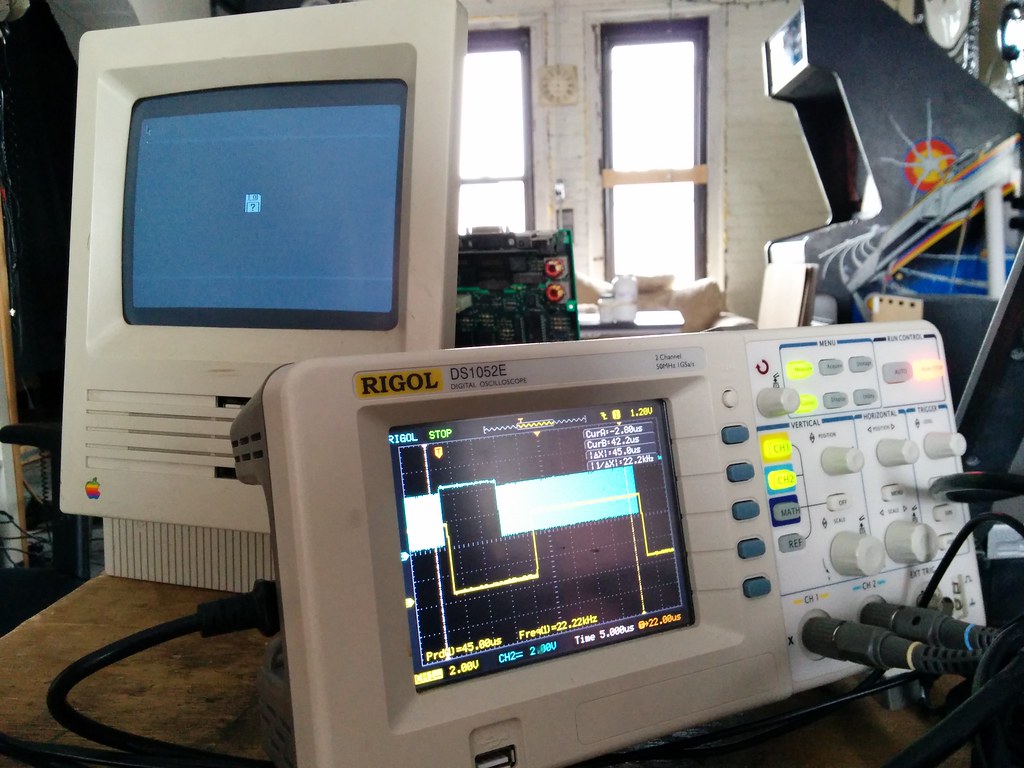 |
 |
Rather than let an old Mac SE with dead drives go to waste, I built a video card interface to the BeagleBone Black to drive the 512x342x1 display using the PRU. Read on for more info...
ADB to USB adapter
 Older Macintosh computers used the Apple Desktop Bus protocol to communicate with keyboards and mice. It is a one-wire, bidirectional multi-drop protocol. More information on my adapter design
Older Macintosh computers used the Apple Desktop Bus protocol to communicate with keyboards and mice. It is a one-wire, bidirectional multi-drop protocol. More information on my adapter design
Unibus Adapter
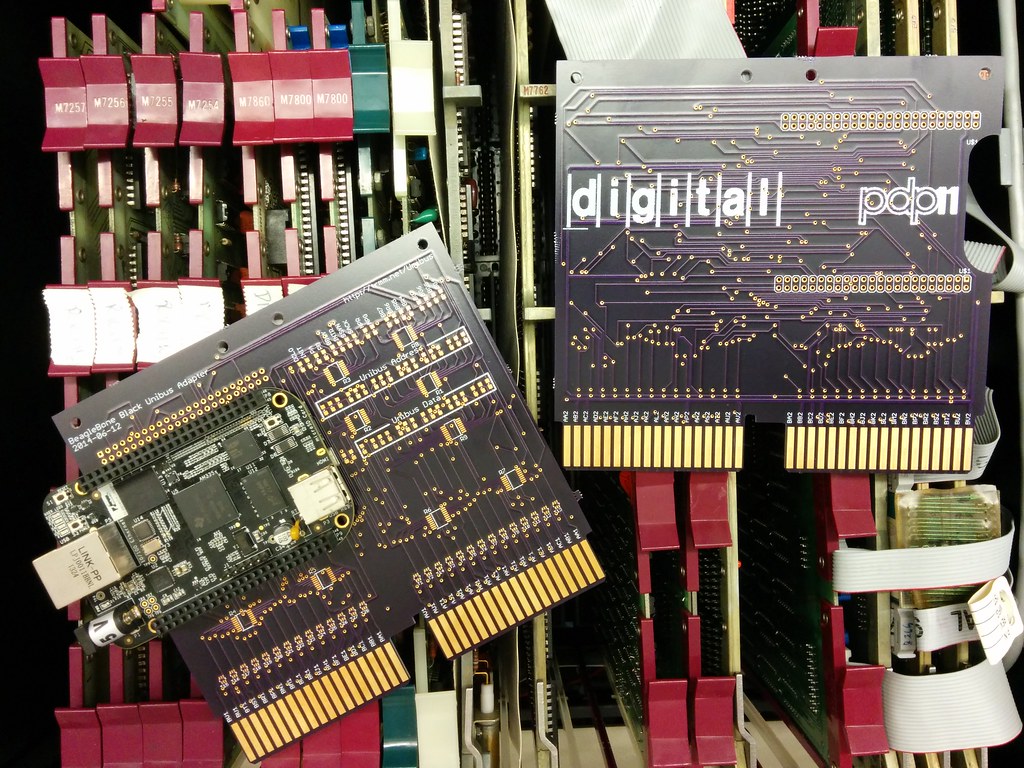 I'm building an adapter from the BeagleBone Black to the DEC Unibus to allow modern CPUs to interface with Unibus devices, or to emulate other devices on the bus, like a network adapter for our PDP-11. There are 56 signals on the bus and the BBB has 55 user GPIO lines, but the DCLO line isn't really necessary since by the time it is asserted it is too late to do anything about it. Read on for more details...
I'm building an adapter from the BeagleBone Black to the DEC Unibus to allow modern CPUs to interface with Unibus devices, or to emulate other devices on the bus, like a network adapter for our PDP-11. There are 56 signals on the bus and the BBB has 55 user GPIO lines, but the DCLO line isn't really necessary since by the time it is asserted it is too late to do anything about it. Read on for more details...
Punch cards and paper tape
IBM Model 129 Card Data Recorder
 |
 |
We restored this IBM 129 Card data recorder to an almost fully functional state and can punch cards fairly reliably now. The circuits are wirewrapped and also feature some of the earliest integrated components. Read on for more info on the IBM 129 Card Data Recorder
IBM 83 Card Sorter
 |
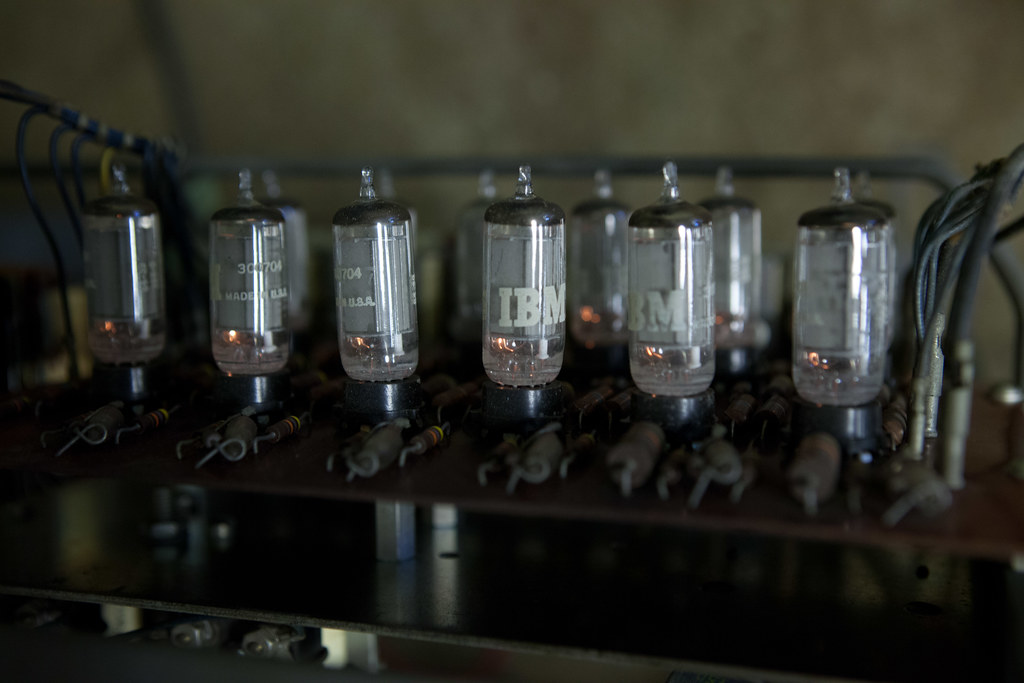 |
This stately IBM 83 Card Sorter is still a work in progress. I can manually crank the cards through it, but the tubes and motor drive do not seem to be functioning. Read on for more details about this device...
Papertapes
 |
 |
I ran across a cache of mid 1960's papertapes and read them with a friend's Model ASR33 Teletype, and then helped another friend build an LED punch tape reader to read some of the 8-bit tapes that didn't read in the 7-bit teletype. More details on the papertapes.
Terminals
Model 15 Teletype
 |
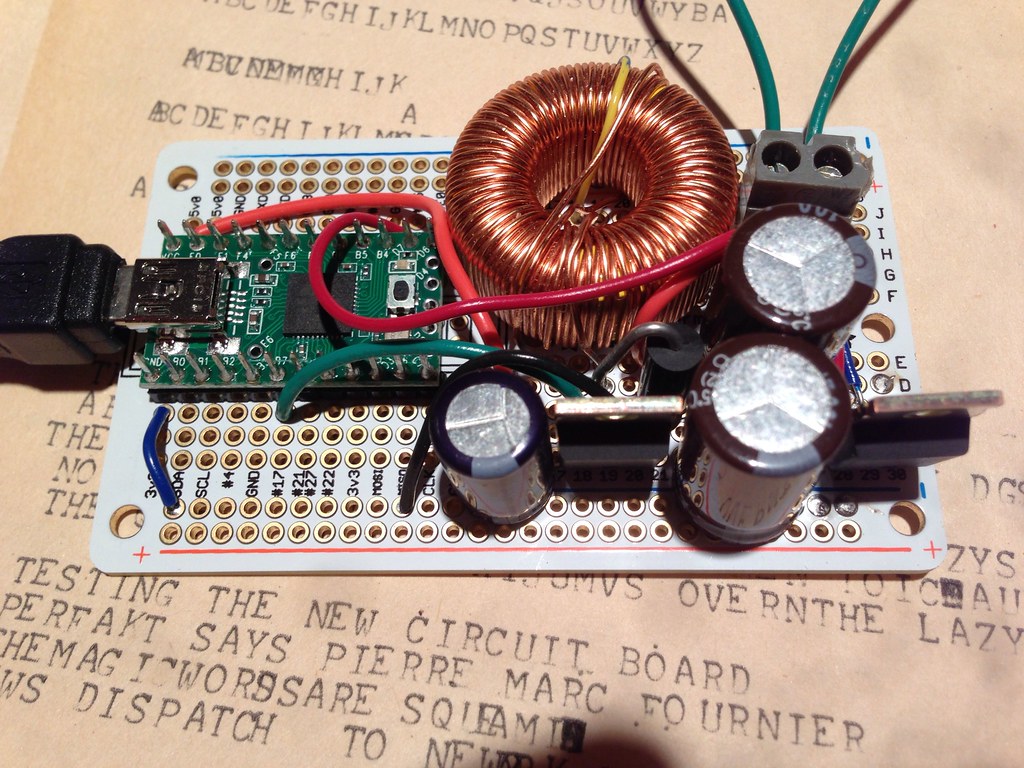 |
To drive a 1930's Model 15 Teletype, I've designed a USB serial port and 100VDC, 60mA current loop boost converter. It converts the ASCII to 5-bit Baudot at 45.5 Baud and generates the high voltage to operate the selector coil. Read on for more details...
Model ASR33 Teletype
 |
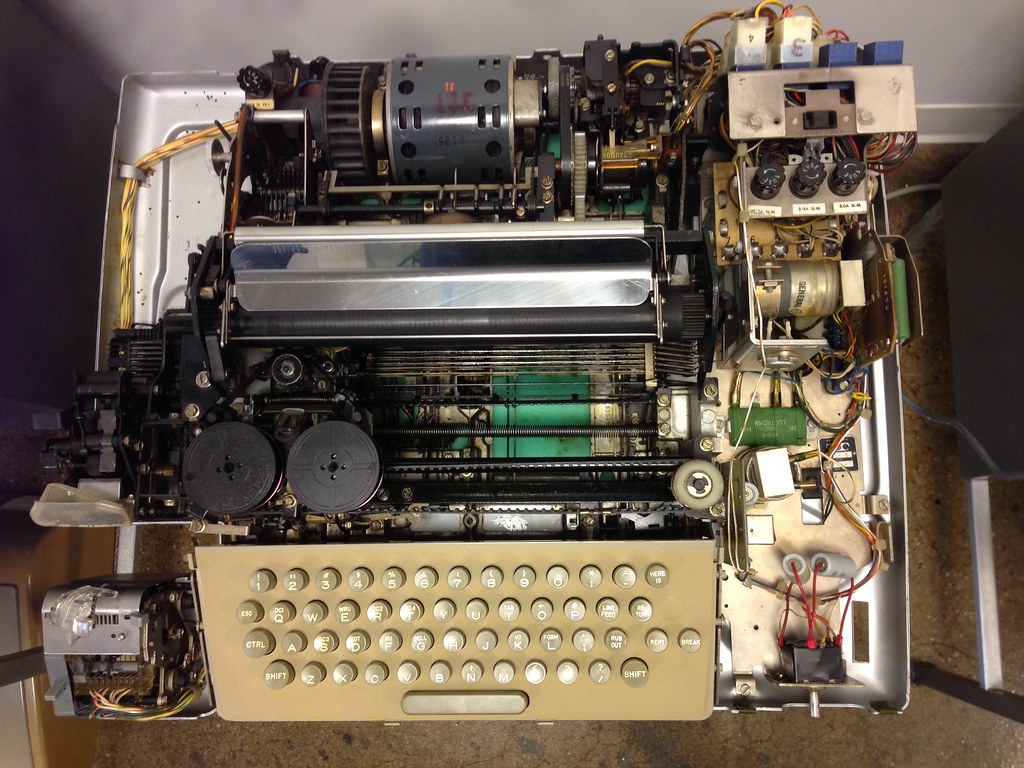 |
A friend of mine has an excellent condition Teletype Model 33 ASR that I've built an 110 baud 7-bit current loop adapter with an auto-on power relay. We've used it to read paper tapes and as a serial console for a Raspberry Pi. The bit encoding and timing is purely mechanical with a rotor very reminscent of the forty year older Model 15 Teletype. Read on for more details...
DEC VT100
 |
 |
We have a few functional VT100s and a stack of broken ones awaiting fixes. Some of them are connected to a BeagleBone running Linux, some of them are connected to a PDP-11/34. Read on for more info on fixing the terminals...
Symbolics keyboard to USB interface
 If you want to connect your Symbolics Lisp machine's keyboard to your more
If you want to connect your Symbolics Lisp machine's keyboard to your more modern recent system, you need to convert it to USB. The interface is quite simple: it looks like a 128-bit shift register with one bit per key on the keyboard. There does not appear to be any ghosting, which means N-key roll over is not an issue! Read on for more details...
Events
Vintage Computer Festival East 8.0
 Over a weekend in 2012 a bunch of NYCR members went to the Vintage Computer Festival East (8.0), held at the InfoAge / MARCH computer history museum in Wall, NJ. Read on for more photos from the musuem...
Over a weekend in 2012 a bunch of NYCR members went to the Vintage Computer Festival East (8.0), held at the InfoAge / MARCH computer history museum in Wall, NJ. Read on for more photos from the musuem...
List of pages
- 45baud.net
- ADB to USB
- ADVENT.FOR on the PDP-11
- Altair
- Boost converter
- Butterfly
- CM 2 references
- CM 2
- Dialup
- Flapple Bird
- IBM 129 Card data recorder
- IBM 83 Card Sorter
- IBM PC
- Kaypro
- Lisa
- Mac SE Easter Egg
- Mac-SE/30 video interface
- Microfiche
- Minivac 601
- Model 15 Teletype
- Model ASR33 Teletype
- Model F
- Motorola MDT9100 conversion
- NeXT Computers
- Pager
- Papertapes
- PDP 11
- PDP-11 Booting
- Pipboy
- Port-O-Rotary
- SaaS
- SHA2017 e-ink Gameboy badge
- SiliconCity
- Simh
- Slackware
- Space Rocks
- Symbolics keyboard USB interface
- TRS80 Model 100 + Raspberry Pi
- Twitter oscilloscope
- Unibus to BeagleBone Black Adapter
- Utah2014
- VCF East 8.0
- Vector display
- VT100